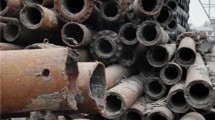Abstract
To study the influence of fluid solid coupling erosion on the joints of gas pipelines, the Fluent DPM model was first used to conduct finite element analysis on several commonly used gas pipeline joints through gas-solid coupling numerical simulation. Secondly, the reasons for erosion of four-way joints and fish tail joints were studied, and the effects of fluid velocity, particle mass, and particle diameter on erosion were compared and analyzed. Finally, two optimization schemes were proposed for these two types of joints. The results show that fish tail joint is generally lower than that of the three-way channel structure. The erosion rate of the fish tail pipe is caused by the large angle between the inlet and outlet channels, which causes particles to directly impact the projection direction of the inlet channel. The erosion rate increases with the increase in velocity and increases with the increase in particle diameter. The use of a double lobe guide structure in the four-ways joint and fish tail joint not only effectively optimizes the internal flow channel, but also reduces wall erosion and avoids large flow velocity zones.





















Similar content being viewed by others
References
X. Chen, J. Wang, A comparison of two-fluid model, dense discrete particle model and CFD-DEM method for modeling impinging gas–solid flows. Powder Technol. 254, 94–102 (2014)
B. Hong, Y. Li, Y. Liu et al., Numerical simulation of solid particle erosion in the gas-liquid flow of key pipe fittings in shale gas fields. Case Stud. Thermal Eng. 42, 102742 (2023)
J. Meng, F. Liang, Z. He et al., Experimental investigation for liquid film characteristics of gas-liquid swirling flow in a horizontal pipe. Int. J. Multiph. Flow. 161, 104400 (2023)
L. Li, Q.-G. Chen, Y. Fang et al., Failure analysis of 2205 duplex stainless steel connecting pipe for composite plate pressure vessel in a high pressure gas field. Int. J. Press. Vessels Pip. 202, 104921 (2023)
B. Zandinava, R. Bakhtiari, G. Vukelic, Failure analysis of a gas transport pipe made of API 5L X60 steel. Eng. Fail. Analy. 131, 105881 (2022)
M. Salem, B. Mechab, M. Berrahou et al., Failure analyses of propagation of cracks in repaired pipe under internal pressure. J. Fail. Anal. Prev. 19, 212–218 (2019)
D. Tyrała, B. Pawłowski, Microstructural aspects of premature pitting corrosion of steel pipe-case study. J. Fail. Anal. Prev. 22, 2147–2153 (2022)
Y. Chen, Wu. Haochen, Y. Chen et al., Erosion - corrosion coupling analysis of shale gas production pipe. Eng. Fail. Anal. 138, 106308 (2022)
X. Zhao, X. Cao, Z. Xie et al., Numerical study on the particle erosion of elbows mounted in series in the gas-solid flow. J. Natl. Gas Sci. Eng. 99, 104423 (2022)
H. Zhu, S. Li, Numerical analysis of mitigating elbow erosion with a rib. Powder Technol. 330, 445–460 (2018)
R. Li, Z. Sun, A. Li et al., Design optimization of hemispherical protrusion for mitigating elbow erosion via CFD-DPM. Powder Technol. 398, 117128 (2022)
A. Li, Z. Wang, L. Zhu et al., Design optimization of guide vane for mitigating elbow erosion using computational fluid dynamics and response surface methodology. Particuology. 63, 83–94 (2022)
C.A.R. Duarte, F.J. de Souza, D.N. Venturi et al., A numerical assessment of two geometries for reducing elbow erosion. Particuology. 49, 117–133 (2020)
H. Zhou, Y. Zhang, H. Ma et al., Inhibition of the erosion-corrosion of elbow by synergistic action of swirling flow and inhibitor. Wear. 514, 204570 (2023)
S.K. Wee, Y.J. Yap, CFD study of sand erosion in pipeline. J. Petrol. Sci. Eng. 176, 269–278 (2019)
J. Zhang, J. Kang, J. Fan et al., Study on erosion wear of fracturing pipeline under the action of multiphase flow in oil & gas industry. J. Natl. Gas Sci. Eng. 32, 334–346 (2016)
M. Liu, H. Liu, R. Zhang, Numerical analyses of the solid particle erosion in elbows for annular flow. Ocean Eng. 105, 186–195 (2015)
Q. Wang, S. Xue, X. Zheng et al., Buried gas pipe leak localization using dual-wave spectrum estimation. Mech. Syst. Signal Process. 198, 110383 (2023)
L. Kong, H. Li, B. Wei et al., Cracking failure analysis of a steel wire-reinforced thermoplastic composite pipe used in an oily sewage conveying system. J. Fail. Anal. Prev. 23, 389–398 (2023)
R.-Y. Zhang, J. Li, H.-W. Yang et al., Experimental study of the critical sand starting velocity of gas-watersand flow in an inclined pipe. Pet. Sci. 19, 2981–2994 (2022)
C. Zhao, J. Li, M. Zaman et al., Investigation of casing deformation characteristics under cycling loads and the effect on casing strength based on full-scale equipment. J. Petrol. Sci. Eng. 205, 108973 (2021)
H. Chen, Z. Dang, S.S. Park et al., Robust CNN-based flow pattern identification for horizontal gas-liquid pipe flow using flow-induced vibration. Exp. Thermal Fluid Sci. 148, 110979 (2023)
G.V. Messa, G. Ferrarese, S. Malavasi, A mixed Euler–Euler/Euler–Lagrange approach to erosion prediction. Wear. 342, 138–153 (2015)
G. Ou, K. Bie, Z. Zheng et al., Numerical simulation on the erosion wear of a multiphase flow pipeline. Int. J. Adv. Manuf. Technol. 96, 1705–1713 (2018)
Acknowledgments
The authors are grateful for the financial support from 2023 Open Fund Project of Sichuan Provincial Key Lab of Process Equipment and Control, (no. GK202310) and 2022 Institute level scientific research project of Guangzhou Railway Vocational and Technical College, (no. GTXYK2203).
Author information
Authors and Affiliations
Corresponding author
Additional information
Publisher's Note
Springer Nature remains neutral with regard to jurisdictional claims in published maps and institutional affiliations.
Rights and permissions
Springer Nature or its licensor (e.g. a society or other partner) holds exclusive rights to this article under a publishing agreement with the author(s) or other rightsholder(s); author self-archiving of the accepted manuscript version of this article is solely governed by the terms of such publishing agreement and applicable law.
About this article
Cite this article
Wang, M., Chen, Y., Liu, Y. et al. Analysis and Optimization of Fluid Solid Coupling Erosion in Gas Pipeline Based on DPM Model. J Fail. Anal. and Preven. 23, 1701–1714 (2023). https://doi.org/10.1007/s11668-023-01716-6
Received:
Revised:
Accepted:
Published:
Issue Date:
DOI: https://doi.org/10.1007/s11668-023-01716-6



